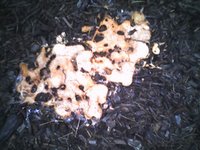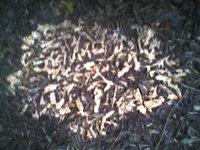 In my daily travels I have been walking past some piles of mulch around some shrubs wondering what animal had vomited up some disgusting crunchy white stuff on the mulch and hoping someone would clean it up. It was disgusting, especially when I thought it was vomit. Coincidentally, the article above appears in Science News and they describe a lumpy yellow crust on mulch in flowerbeds that is sometimes called "dog-vomit slime". I finally made the connection to my unpleasant mulch experience. That wasn't dog vomit, it was nature, right there in front of me. That particular slime mold is called Fuligo septica.
In my daily travels I have been walking past some piles of mulch around some shrubs wondering what animal had vomited up some disgusting crunchy white stuff on the mulch and hoping someone would clean it up. It was disgusting, especially when I thought it was vomit. Coincidentally, the article above appears in Science News and they describe a lumpy yellow crust on mulch in flowerbeds that is sometimes called "dog-vomit slime". I finally made the connection to my unpleasant mulch experience. That wasn't dog vomit, it was nature, right there in front of me. That particular slime mold is called Fuligo septica. When it dries out it is sometimes called scrambled-egg slime due to its consistency. I took a picture of an example of that form I found on the opposite side of the shrub from the slime above. Isn't it great when book learning (in this case science magazine learning) impacts practical experience. There is biodiversity to be measured all around you, even in your yard.
When it dries out it is sometimes called scrambled-egg slime due to its consistency. I took a picture of an example of that form I found on the opposite side of the shrub from the slime above. Isn't it great when book learning (in this case science magazine learning) impacts practical experience. There is biodiversity to be measured all around you, even in your yard.The article went on to talk about all of the other mushrooms and other fungi that can pop out of mulch and soil after a rain and the supplemental references on the web (pictures of slime molds, and introduction to slime molds) will allow me to identify other slime molds and fungi in may travels.
tags: slime mold, science, biodiversity, gardening
No comments:
Post a Comment